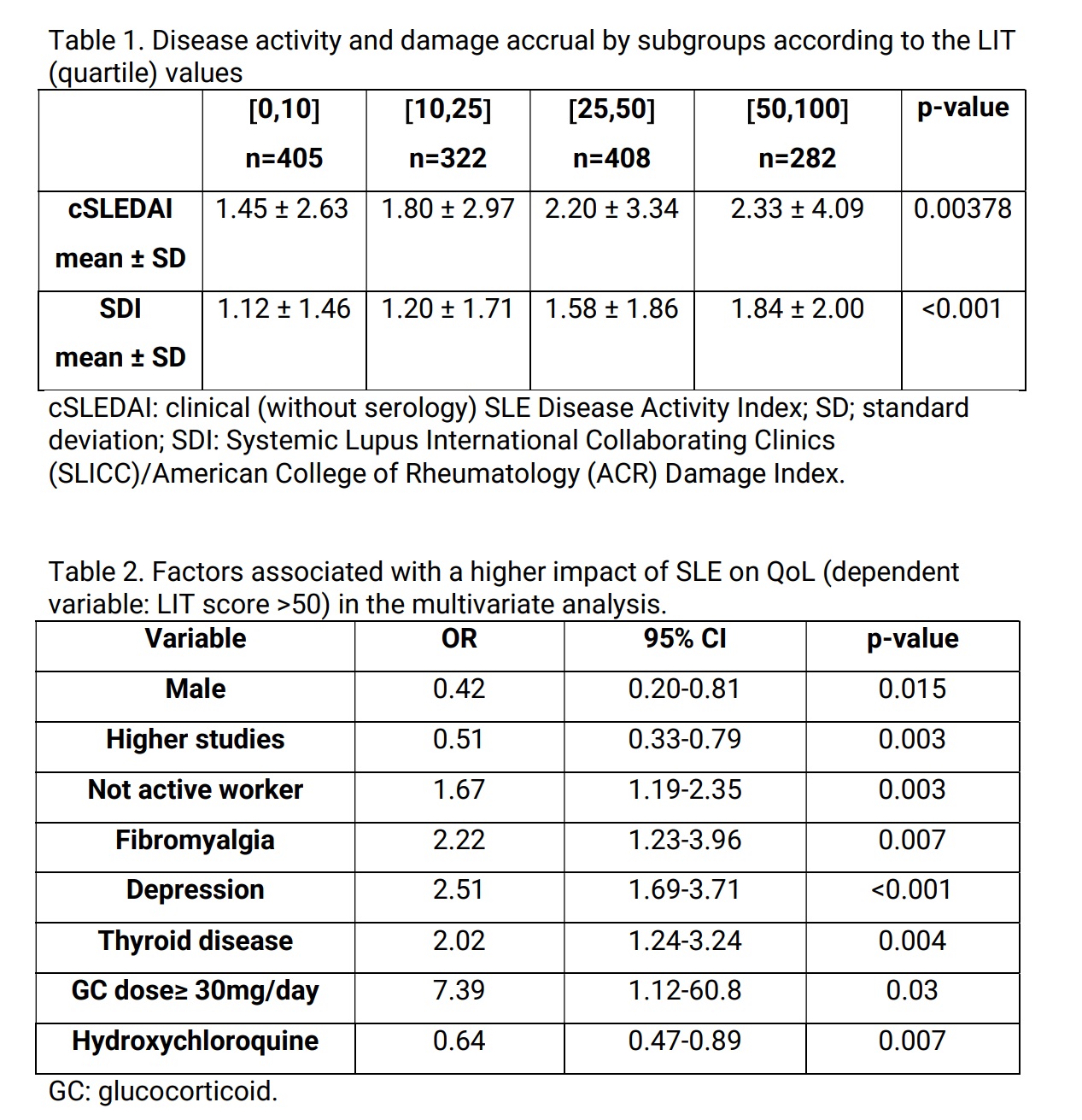Session Information
Session Type: Poster Session A
Session Time: 10:30AM-12:30PM
Background/Purpose: Improving quality of life (QoL) is one of the key targets when treating systemic lupus erythematosus (SLE) patients. The Lupus impact Tracker (LIT) is a 10-item questionnaire that has demonstrated being a reliable and valid tool to assess the impact (1) of the disease in SLE patients. LIT may range between 0 (no impact on QoL) and 100 (maximum impact on QoL)
Methods: The study population corresponds to RELESSER-PROS prospective cohort with data from patients at their first annual visit (V1). The LIT score was divided into 4 groups based on the quartile distribution, and the distribution of variables in each of the 4 groups was analysed. The Chi-square or Fisher test was used for categorical variables, while ANOVA or Kruskal-Wallis tests were employed for continuous variables. Subsequently, a logistic regression model was fitted to analyse the variables influencing the presence of LIT scores > 50 points. A significance level of 5% was used for the entire analysis, and the R software was employed.
Results: A total of 1417 SLE patients were prospectively included in the study: 1275 (90%) female/142 (10%) male; 1299 (94.2%) Caucasian. The mean (±SD) age at SLE diagnosis and at study entry (V1) were 34.7 (±13.9) and 56.0 (±1.0) years, respectively. The median (Q1-Q3) value of LIT at V1 was 25 (10-47.5). The domains of LIT who scored the most for the final value were “pain/fatigue” with a mean (±SD) score per question: 1.52 (±1.07) and “emotional health” with 1.29 (±1.18). On the other hand, the domains of LIT that scored the least were “body image dissatisfaction” and “lupus medication adverse effects” with 0.87 (±1.20) and 0.69 (±1.09) per question, respectively. At V1, the mean (±SD) clinical (without serology) SLEDAI score was 1.92 (±3.26) and the mean (±SD) SLE Damage Index (SDI) score was 1.42 (±1.77). We observed significantly higher cSLEDAI and SDI scores in the subgroup of patients with higher (50,100) LIT values (Table 1). When we performed a bivariant correlation analysis between LIT score and both cSLEDAI and SDI we observed that correlation was low: Spearman’s Correlation Coefficient 0.093 and 0.17, respectively. We observed that patients with higher LIT values were less likely in LLDAS and in 2021 DORIS remission (p=0.04 for remission). We also analyse the influence of some variables other than activity and damage on QoL of SLE patients such as educational and laboral status, comorbidities and therapies. We carried out a multivariant analysis, defining “LIT score > 50” as the dependent variable. Table 2 shows the variables with significant independent association with a higher impact of SLE on QoL in the multivariate analysis.
Conclusion: SLE has a significant impact on QoL of the patients, “pain/fatigue” and “emotional health” being the domains of QoL affected the most.
Comorbidities such as fibromyalgia, depression and thyroid disease; as well as being on higher daily dose of prednisone are significantly associated with higher impact on QoL of SLE patients.
On the other hand, some socioeconomic variables and being on hydroxychloroquine are significantly associated with better QoL.
These results highlight the relevance of considering these factors when making clinical decisions, optimizing care of SLE patients.
To cite this abstract in AMA style:
FERNÁNDEZ-FERNÁNDEZ D, Mamani I, Rúa-Figueroa Í, Roberts K, Mouriño C, Menor Almagro R, Olivé-Marqués A, Galindo-Izquierdo M, Fernández-Nebro A, Calvo-Alén J, ERAUSQUIN ARRUABARRENA M, Freire González M, Blanco-Alonso R, Hernández Beriain J, Montilla C, Moriano C, Ibáñez-Barceló M, Rosas-Gómez de Salazar J, Arevalo Salaet M, Ibarguengoitia-Barrena O, Tomero Muriel E, Andreu J, Vela-Casasempere P, NARVAEZ F, Bohorquez C, Iniguez Ubiaga C, salgado-Pérez E, Torrente Segarra V, Salman Monte: T, OLLER RODRIGUEZ J, Pego-Reigosa J. Bridging the Gap Between Patient’s Perception on Quality of Life and Disease Activity and Damage in Systemic Lupus Erythematous Patient [abstract]. Arthritis Rheumatol. 2024; 76 (suppl 9). https://acrabstracts.org/abstract/bridging-the-gap-between-patients-perception-on-quality-of-life-and-disease-activity-and-damage-in-systemic-lupus-erythematous-patient/. Accessed .« Back to ACR Convergence 2024
ACR Meeting Abstracts - https://acrabstracts.org/abstract/bridging-the-gap-between-patients-perception-on-quality-of-life-and-disease-activity-and-damage-in-systemic-lupus-erythematous-patient/

